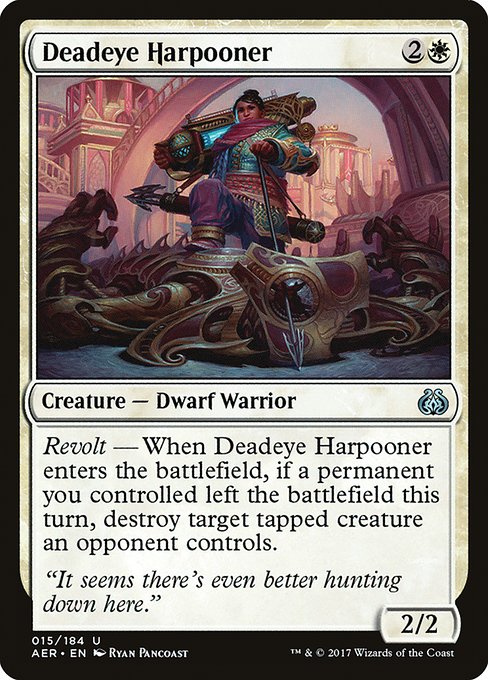
Image courtesy of Scryfall.com
Balancing Risk and Reward with Deadeye Harpooner in Aether Revolt
If you’ve ever built a deck that leans into clever timing and a little bit of gambit, Deadeye Harpooner is the kind of card you love to pet and then deploy. This white dwarf warrior from the Aether Revolt set costs {2}{W} and carries a modest 2/2 body for three mana. But the true payoff is Revolt, a trigger that asks you to weigh risk against reward: when this creature enters the battlefield, if a permanent left the battlefield under your control this turn, you may destroy a target tapped creature an opponent controls. It’s a perfect microcosm of MTG’s risk-versus-reward spirit—if you can make the condition happen, you turn a simple beat stick into a reliable removal engine. 🧙♂️🔥
The flavor text, “It seems there’s even better hunting down here,” sets the tone for Deadeye Harpooner’s role in a commander list or a midrange white tempo shell. The artwork by Ryan Pancoast captures a wiry, determined hunter who uses a sharp sense of timing as much as a harpoon. In practical terms, you’re not just paying for a 2/2 body; you’re drafting a reliable, conditional removal spell with legs. The card’s identity—white, with a revolt mechanic—slots neatly into Aether Revolt’s broader themes of machines, invention, and disciplined efficiency. 🎨⚔️
What Revolt Really Demands on the Battlefield
Revolt is not a passive stat check; it’s an opportunity cost mechanic. To make Deadeye Harpooner sing, you need something on your side to leave the battlefield this turn. That could be:
- A creature you sacrificed to a sac outlet or a spell that forces a sacrifice.
- A removal spell that takes out one of your own temporary threats or a permanent you control (think of spells that bounce or exile as part of a removal line).
- A cheaper sacrifice or a one-time effect that clears your board, setting up a later swing with Harpooner’s ETB trigger.
Once the condition is met, you’ve effectively turned a 3-mana 2/2 into a targeted creature destruction tool for your opponent. It’s not about instant speed destruction; it’s about the right timing. If your opponent has a tapped threat late in the game, Deadeye Harpooner can answer it cleanly—especially if you’ve been setting up a little controlled chaos earlier in the turn. The payoff is clean, efficient, and flavorful in the way only a revolting gadgetry-themed white card can be. 🧲🔥
Practical Play and Deckbuilding Notes
When you’re building around Deadeye Harpooner, you’re aiming for tempo, synergy, and late-game inevitability. Here are a few practical ideas to consider:
- Tempo over raw power: Don’t overcommit to creatures if you can’t trigger Revolt. The card shines when you can guarantee at least one permanent left the battlefield this turn. A single well-timed sacrifice or removal spell can unlock Harpooner’s full potential.
- Pair with low-cost removal: White has plenty of efficient answers for tapped threats. By combining Harpooner with spells that remove a blocker or threaten a tap, you increase the likelihood that you’ll have a valid target for destruction once the Revolt condition is met.
- EDH/Commander synergy: In multiplayer formats, Deadeye Harpooner becomes a reliable way to pressure multiple opponents. The Revolt trick can catch a table off-guard, turning a 2/2 into a timely removal in a way that feels both fair and satisfying. The card’s cost and written effect make it a solid inclusion in many white-focused lists.
- Blowout potential in early turns: If you can arrange a turn where a permanent leaves your side first, Harpooner’s enter-the-battlefield effect can wipe a key tapped creature from your opponent’s board, swinging tempo in your favor and leaving your opponent with a tough choice.
“It’s not just about the harpoon; it’s about the timing.”
From a gameplay perspective, the synergy between Harpooner’s text and Revolt’s clause rewards careful planning. The card’s color identity and rarity (uncommon) place it in the sweet spot for decks that don’t want to overextend into expensive threats but still crave a decisive moment of removal. The set, Aether Revolt, was all about engineering, gadgets, and clever play—Deadeye Harpooner embodies that ethos with a clean, efficient package. The art by Ryan Pancoast adds personality and lore to a mechanic that often lives in the margins of spice and tempo. 🧙♂️🎲
Value, Collectibility, and Culture
In terms of market value, Deadeye Harpooner tends to hover in the budget-friendly corner of MTG. Current price data suggest a modest foil premium on rare occasions, but for most players, the nonfoil version is a practical pickup. Its EDHrec footprint is modest, yet it remains a flavorful inclusion for commanders who want a reliable white removal engine with a twist. If you’re chasing a casually cool collection, the aura of the set’s invention-and-gear theme makes this a memorable piece, even if the price tag won’t break the bank. 💎
As you plan long sessions on the table or online, small upgrades can transform your setup. That’s where cross-promotion comes in—consider a reliable non-slip gaming mouse pad to keep your grip steady as you calculate the exact moment to push the Revolt trigger. For a smooth setup between rounds, check out the Non-Slip Gaming Mouse Pad 9.5x8 and keep the focus where it belongs: on the tabletop, where destinies are decided with a well-timed Harpooner swing. 🎨⚔️
In the end, Deadeye Harpooner isn’t a card you play for raw power; it’s a card you play for timing and nerve. It rewards players who keep a close eye on the battlefield’s ebb and flow and who are brave enough to gamble on a permanent leaving the field to unlock a wrenching, tapped-creature destruction. That’s the heartbeat of a good gambit—risk, reward, and a dash of dwarven precision. 🧙♂️💥